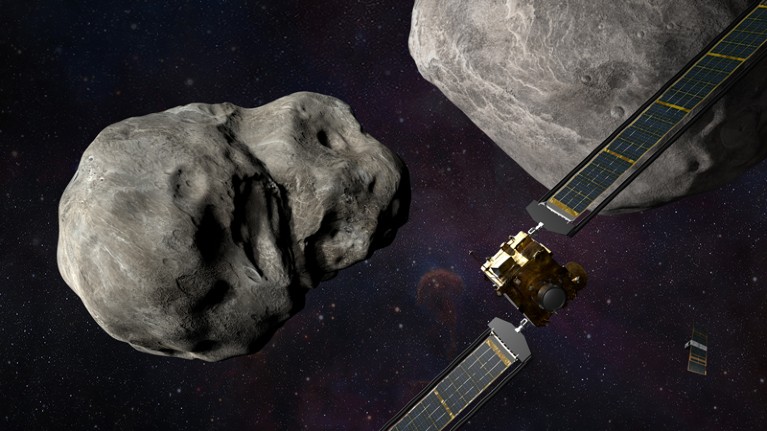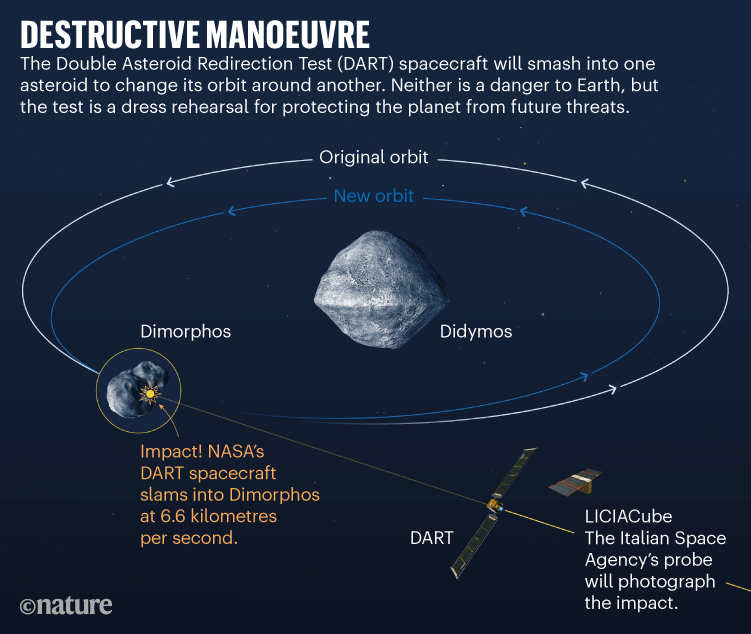[ad_1]

The DART spacecraft will smash into the asteroid Dimorphos, and the LICIACube probe (bottom right) will snap photos of the aftermath, as shown in this artist’s rendering.Credit: NASA/Johns Hopkins APL/Steve Gribben
On 26 September, at 7:14 p.m. US eastern time, NASA will strike a pre-emptive blow against the dangers of the Solar System. That’s when, 11 million kilometres from Earth, the agency is set to smash a spacecraft into an asteroid. The goal is to knock the harmless space rock into a slightly different orbit to test whether humanity could do such a thing if a dangerous asteroid were ever detected heading for Earth1.
The Double Asteroid Redirection Test (DART) spacecraft will meet its end when it crashes into the asteroid Dimorphos, which is about 160 metres across. “We describe it as running a golf cart into the Great Pyramid,” says Nancy Chabot, a planetary scientist at the Johns Hopkins University Applied Physics Laboratory in Laurel, Maryland.
Record number of asteroids seen whizzing past Earth in 2020
The endeavour is reminiscent of Bruce Willis saving Earth by blasting a wayward asteroid in the 1998 film Armageddon. And the whole event will unfold like a film when it’s broadcast on NASA’s website. DART’s camera will focus on Dimorphos and the larger asteroid that it orbits, Didymos, as the spacecraft approaches.
At first, DART will not be able to distinguish between the two asteroids, but when it gets close enough, its view will resolve into two points of light. The spacecraft will continue to hurtle towards Dimorphos, snapping images once per second and sending them to Earth until the asteroid’s rubbly surface fills the field of view. “We are super excited to see what it’s going to look like,” says Michelle Chen, a software engineer at the Johns Hopkins lab. Then the footage will end abruptly, as DART smashes into the surface.
Aftermath of a smash
But the US$330-million mission aims to accomplish some science before the credits roll. DART will study the effects of injecting kinetic energy — from an impact at 6.6 kilometres per second — into an asteroid. Dimorphos might absorb much of that energy or it might partially break apart, depending on whether it is made of solid rock or is a loose agglomeration of space pebbles2. Small asteroids are “little geophysical and geological worlds”, says Patrick Michel, a planetary scientist at the Côte d’Azur Observatory in Nice, France. “What DART will see, we don’t know.”
Researchers will get their best view of the collision’s aftermath from another spacecraft that will fly by. An Italian probe named LICIACube is travelling a little behind DART and will zip past Dimorphos just three minutes after the impact. Its cameras will snap images before and after the crash. LICIACube will see whatever is left of the DART spacecraft — unless the impact kicks up a cloud of dust big enough to obscure the view3,4. The most exciting images from LICIACube should be available within 24 hours of the crash, says Simone Pirrotta, the probe’s project manager at the Italian space agency ASI in Rome.
The impact might not leave behind a crater if Dimorphos absorbs much of DART’s kinetic energy, says Adriano Campo Bagatin, a planetary scientist at the University of Alicante in Spain. Visits to other asteroids have shown just how complicated and surprising space rocks can be. Beginning in 2018, for example, NASA’s OSIRIS-REx spacecraft spent two years orbiting and studying the asteroid Bennu, but when it moved in to collect a sample, Bennu turned out to be a loose collection of pebbles that responded in unexpected ways to the sampling arm.
Confirming success
With Dimorphos, it will take days to weeks before mission scientists can confirm whether the test worked. The goal is to speed up Dimorphos’s orbit, cutting the time it takes to travel around Didymos by 10–15 minutes (see ‘Destructive manoeuvre’). Scientists will learn whether this has happened by using telescopes on Earth to observe how Dimorphos blocks the light from Didymos, and vice versa, as the smaller asteroid circles the larger.

Source: This graphic was repurposed from this story, by Alexandra Witze.
Observatories on every continent will measure the aftermath of the crash, as will the Hubble and James Webb space telescopes. “I’m going to be rooting for every single observer,” says Cristina Thomas, a planetary scientist at Northern Arizona University in Flagstaff who leads the observation teams. Changes to Dimorphos’s orbit will probably become apparent around 1–2 October, or even earlier, depending on how quickly the cloud of dust clears after the impact. Researchers will have to wait until 2027 for another close-up look, when a European Space Agency mission called Hera visits the asteroid to study the crash site5.
Dimorphos and Didymos are not a threat to Earth — and they won’t be after the test. NASA just wants to understand whether it has the ability to deflect a space rock of Dimorphos’s size, which could devastate a region of Earth if it were to hit the planet.
The agency is surveying the cosmos for threatening asteroids, but the project is behind schedule. With the telescopes currently available on Earth, it would take another three decades to finish. And this year, NASA delayed the launch of a long-awaited space telescope that would help hunt these asteroids, from 2026 to no earlier than 2028.
“The most important thing to keep in mind about any of these deflection techniques is they rely on having enough time to work,” says Amy Mainzer, a planetary scientist at the University of Arizona in Tucson and principal investigator of the planned telescope. “The key is finding objects well ahead of any potential impact.”
[ad_2]
Source link


